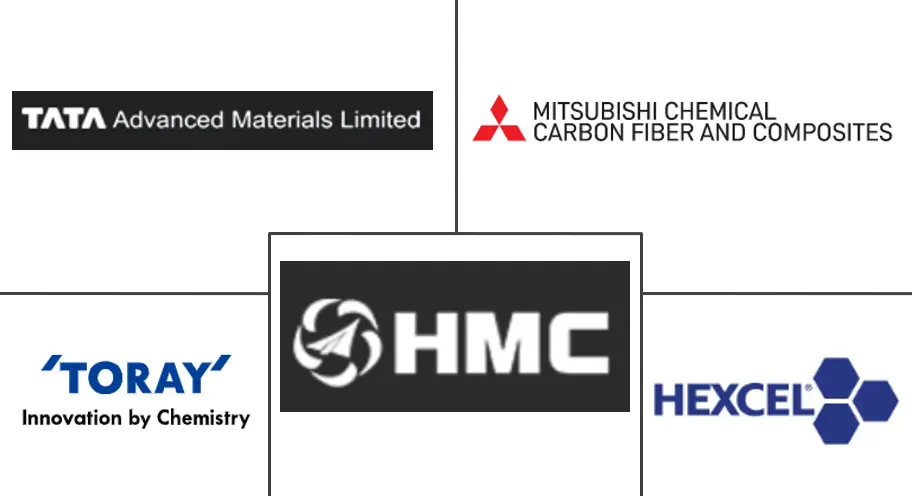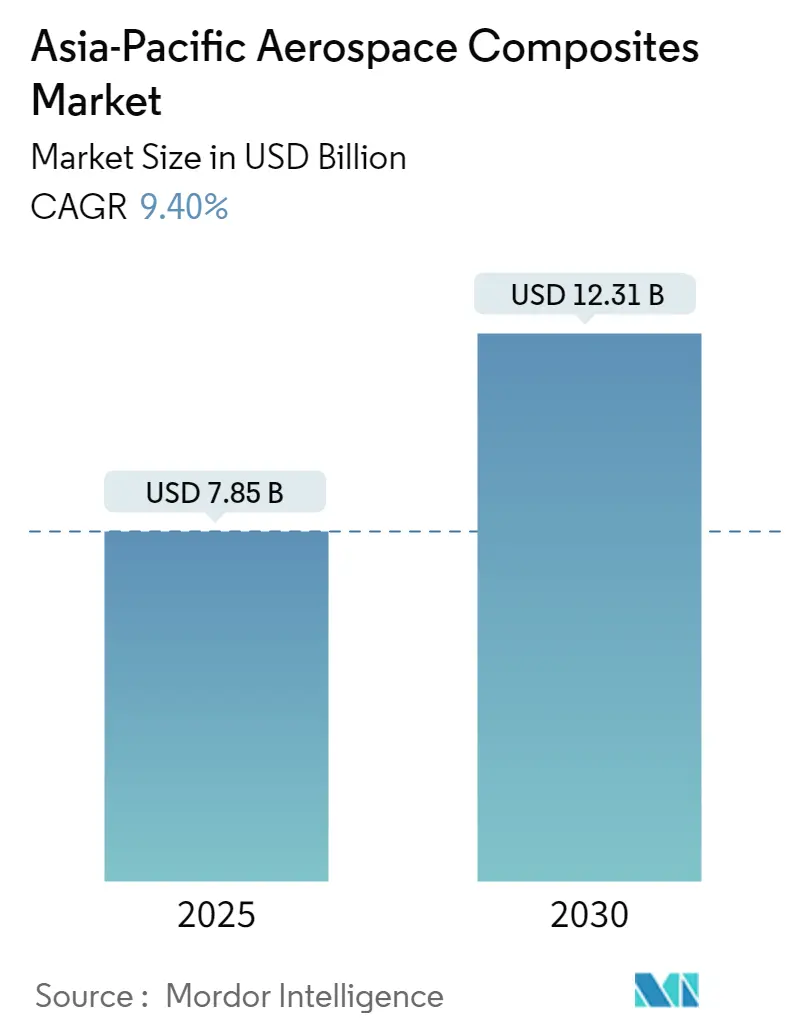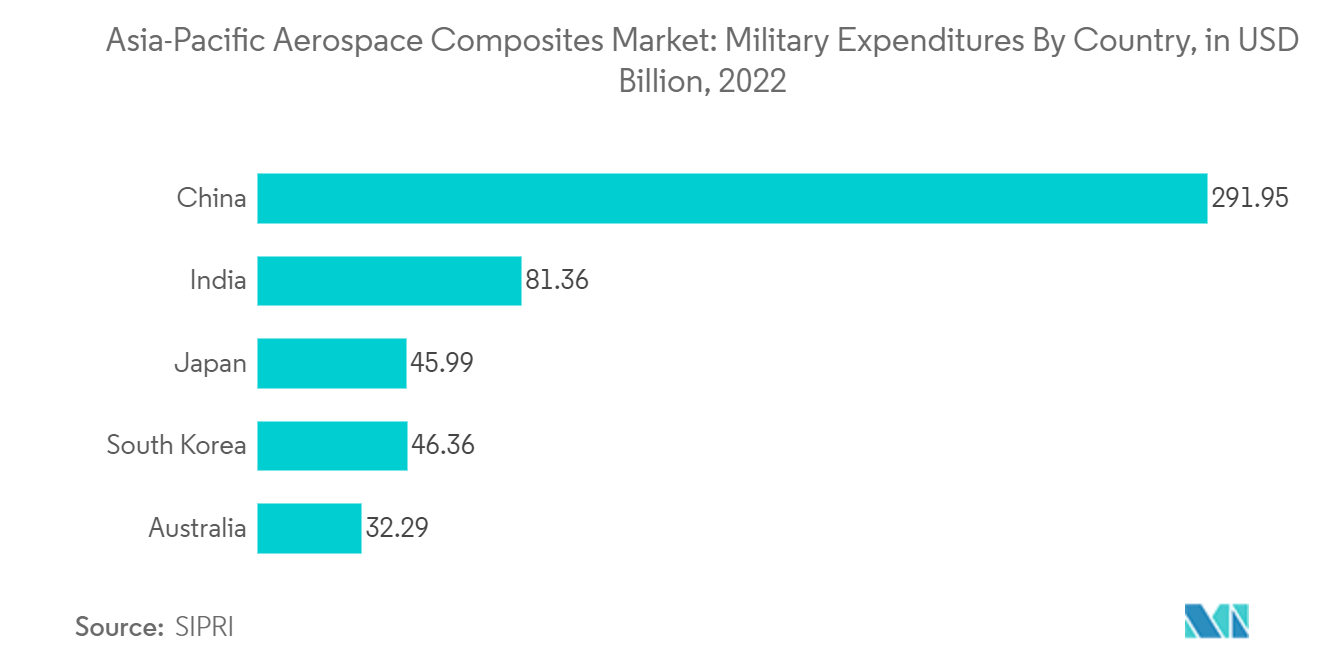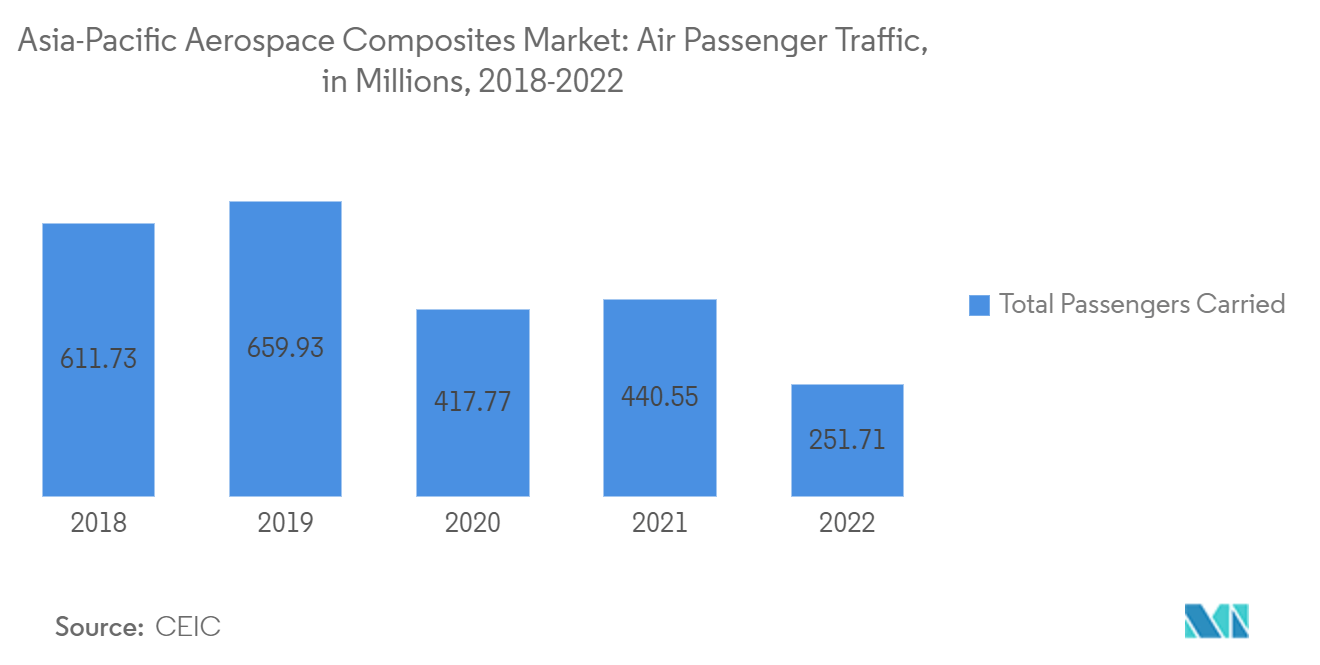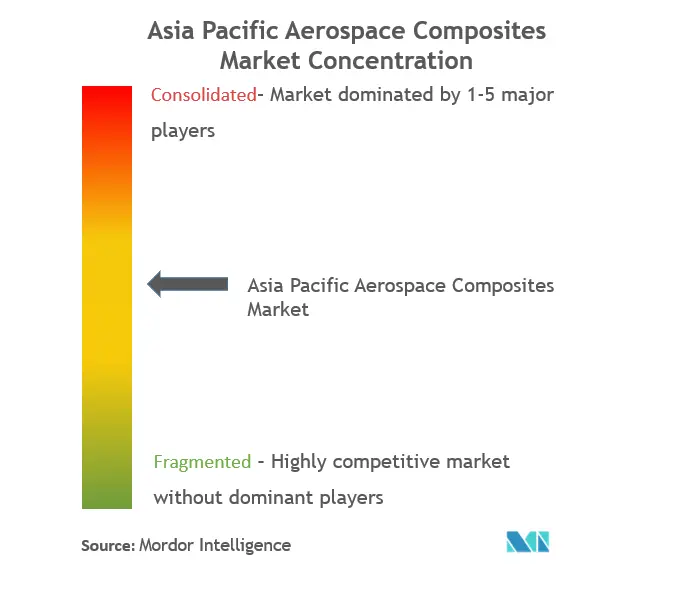Asia-Pacific Aerospace Composites Market Analysis
The Asia-Pacific Aerospace Composites Market size is estimated at USD 7.85 billion in 2025, and is expected to reach USD 12.31 billion by 2030, at a CAGR of 9.4% during the forecast period (2025-2030).
Asia-Pacific is the fastest-growing region in the world for aviation activities. With the air-passenger traffic growing rapidly and the airlines increasing their fleet size, the market for aerospace composites in the region is growing rapidly, and the growth is expected to continue during the forecast period. In addition, in the military segment, several nations in the region are procuring newer generation aircraft which have a greater percentage of composites.
Several new aircraft developed by the players in the region are being built with increasingly higher compositions of composite materials. Reduced maintenance, longer design life, fewer parts, and reduced tooling and assembly costs are some of the reasons that are driving the adoption of composites in aerospace manufacturing. However, factors such as supply chain disruptions and liquidity crunch can hinder the growth of the market.
Asia-Pacific Aerospace Composites Market Trends
Military Aviation is Expected to Dominate the Market During the Forecast Period
The military aircraft segment is expected to be driven by the growth in the adoption of composites in various parts and components of the newer generation of military aircraft. The composites used in military aircraft are lightweight, durable, and chemical and temperature-resilient. An important use of composite materials is in the development of stealth aircraft that use radar-absorbing composite materials to form most of the aircraft’s structure. Carbon- and glass fiber-reinforced plastic laminates are used in Lockheed Martin F-35 Lightning II in structures, like vertical stabilizers, tail, flaps, and wings’ skin, that account for approximately 40% of the weight of the aircraft. For instance, in January 2023, BAE Systems Australia secured a new contract with Lockheed Martin to activate an F-35 Asia-Pacific Regional Warehouse at its Williamtown aircraft sustainment operations in regional New South Wales. Also, in February 2023, Singapore announced that the country would purchase eight additional F-35B Lightning II fighter jets on top of the four for which a deal was signed in 2019. The announcement indicates that the F-35s are rapidly proliferating in China’s neighborhood. Thus, the growing use of composites in the newer generation of military aircraft and the increasing procurement of such aircraft are currently driving the growth of the military segment.
China to Hold the Largest Market Share in the Market During the Forecast Period
China holds the largest share of the market during the forecasted period. Globally, China is one of the fastest-growing aviation markets. In 2022, commercial airports in China handled over 2,511 million passengers, compared to 440 million passengers in 2022. The growth in the aviation market is generating demand for new aircraft by the carriers in China. As most of the newer generation aircraft use composites in various aircraft parts, the demand for the same is expected to increase. In July 2020, Airbus confirmed receiving orders from Air China, China Eastern, China Southern, and Shenzhen Airlines for a total of 292 A320 family of aircraft, demonstrating the positive recovery momentum and prosperous outlook for the Chinese aviation market. The A320 airframe includes composite materials and aluminum alloys to save weight and reduce the total number of parts to decrease maintenance costs. Also, in March 2023, the Tianjin-based final assembly facility commissioned a composites-intensive A321neo for Juneyao Air. All these factors are expected to boost the country's market prospects during the forecast period.
Asia-Pacific Aerospace Composites Industry Overview
The Asia-Pacific aerospace composites market is semi-consolidated, wherein prominent players occupy the majority of the market share. Some of the prominent players in the market are Toray Industries Inc., Harbin Hafei Airbus Composite Manufacturing Centre Co. Ltd, Mitsubishi Chemical Carbon Fiber and Composites Inc., Hexcel Corporation, and TATA Advanced Materials Limited. As aerospace component manufacturing increases in the Asia-Pacific region, local players are partnering with aircraft OEMs for the indigenous development of components and parts of the aircraft to reduce overall manufacturing costs. This is opening new market opportunities for the local players in the region to grow in the market. Also, companies' investments in advanced composites for space-based applications may help them increase their market presence in the Asia-Pacific in the years to come.
Asia-Pacific Aerospace Composites Market Leaders
-
Harbin Hafei Airbus Composite Manufacturing Centre Co., Ltd.
-
Toray Industries Inc.
-
Mitsubishi Chemical Carbon Fiber and Composites Inc.
-
Hexcel Corporation
-
TATA Advanced Materials Limited
- *Disclaimer: Major Players sorted in no particular order
Asia-Pacific Aerospace Composites Market News
Mar 2023: Airbus delivered the first A321neo aircraft assembled at its final assembly line in Asia (FAL Tianjin) to China’s Juneyao Air airline in Tianjin, China. The A321 variant makes extensive use of weight-saving composites supplied by Hexcel Corporation.
Nov 2022: GAMECO and THALES signed an industrial collaboration agreement to further cooperation in MRO activities. Thales will continue providing support to GAMECO in the areas of aircraft maintenance, the procurement distribution of aviation supplies, technical documentation, and Test Program Sets (TPS).
Asia-Pacific Aerospace Composites Industry Segmentation
Aerospace composites are chosen for their ability to provide a combination of lightweight, high strength, corrosion resistance, and fatigue resistance. These characteristics make composites particularly suitable for applications where traditional materials like metals might be less efficient due to their weight or susceptibility to corrosion.
The Asia-Pacific Aerospace Composites Market is segmented by Application (Commercial Aircraft, Military Aircraft, General Aviation Aircraft, and Space) and Geography (China, India, Japan, South Korea, Australia, and the Rest of Asia-Pacific). The report offers the market size in value terms in USD for all the abovementioned segments.
| Application | Commercial Aircraft | ||
| Military Aircraft | |||
| General Aviation Aircraft | |||
| Space | |||
| Geography | Asia-Pacific | China | |
| India | |||
| Japan | |||
| South Korea | |||
| Australia | |||
| Rest of Asia-Pacific | |||
Asia-Pacific Aerospace Composites Market Research FAQs
How big is the Asia-Pacific Aerospace Composites Market?
The Asia-Pacific Aerospace Composites Market size is expected to reach USD 7.85 billion in 2025 and grow at a CAGR of 9.40% to reach USD 12.31 billion by 2030.
What is the current Asia-Pacific Aerospace Composites Market size?
In 2025, the Asia-Pacific Aerospace Composites Market size is expected to reach USD 7.85 billion.
Who are the key players in Asia-Pacific Aerospace Composites Market?
Harbin Hafei Airbus Composite Manufacturing Centre Co., Ltd., Toray Industries Inc., Mitsubishi Chemical Carbon Fiber and Composites Inc., Hexcel Corporation and TATA Advanced Materials Limited are the major companies operating in the Asia-Pacific Aerospace Composites Market.
What years does this Asia-Pacific Aerospace Composites Market cover, and what was the market size in 2024?
In 2024, the Asia-Pacific Aerospace Composites Market size was estimated at USD 7.11 billion. The report covers the Asia-Pacific Aerospace Composites Market historical market size for years: 2019, 2020, 2021, 2022, 2023 and 2024. The report also forecasts the Asia-Pacific Aerospace Composites Market size for years: 2025, 2026, 2027, 2028, 2029 and 2030.
Our Best Selling Reports
Asia-Pacific Aerospace Composites Industry Report
Statistics for the 2025 Asia-Pacific Aerospace Composites market share, size and revenue growth rate, created by Mordor Intelligence™ Industry Reports. Asia-Pacific Aerospace Composites analysis includes a market forecast outlook for 2025 to 2030 and historical overview. Get a sample of this industry analysis as a free report PDF download.

